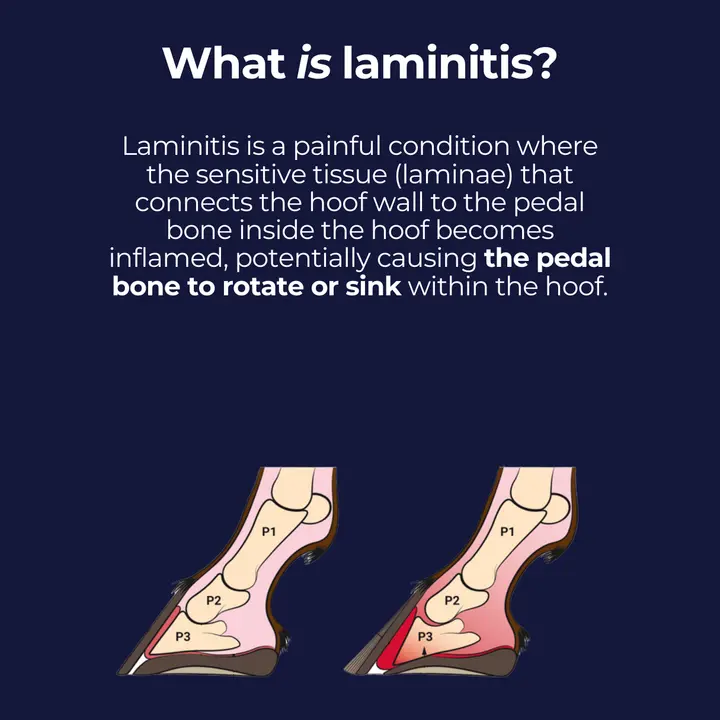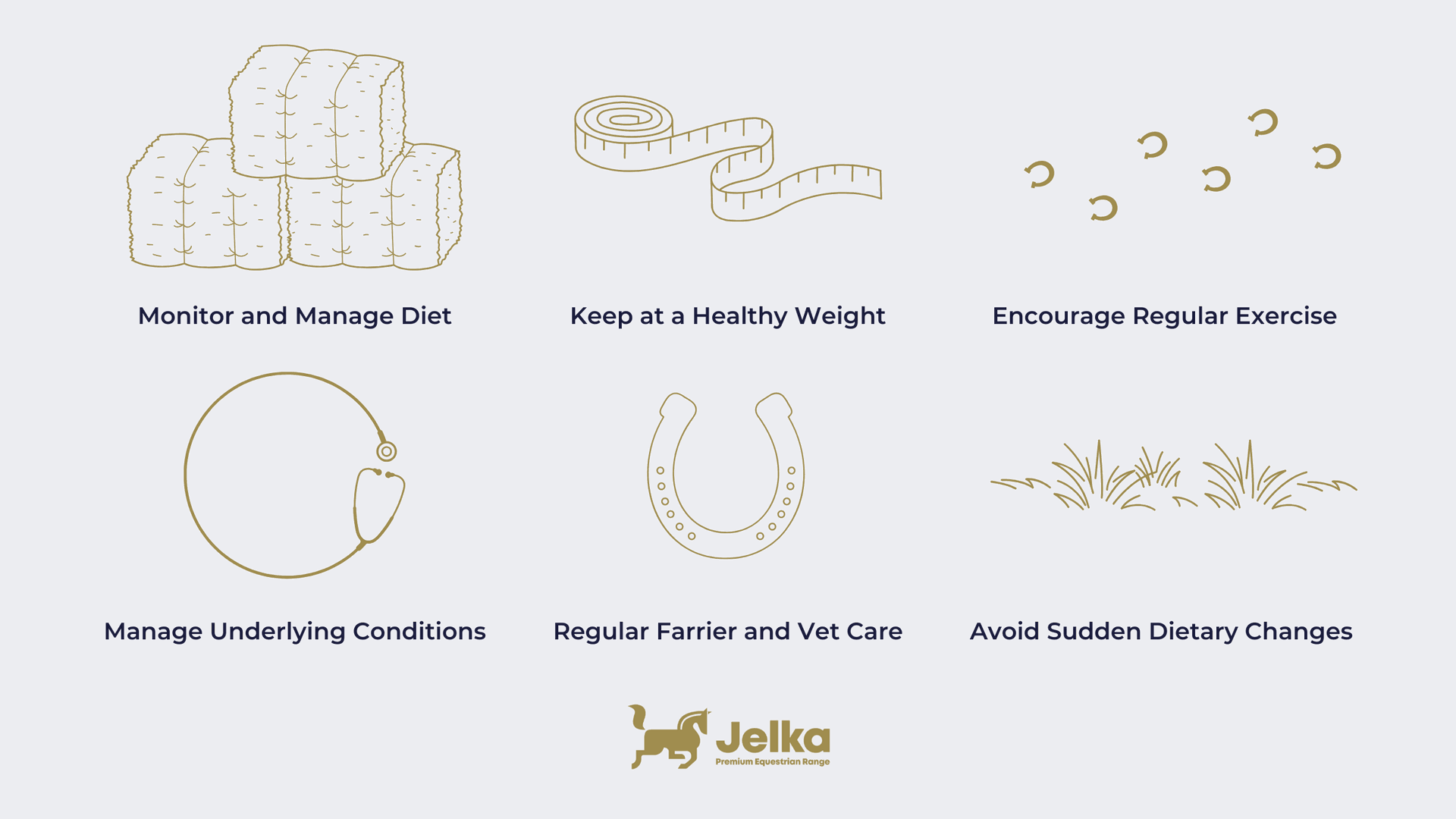Understanding Laminitis In Horses
Laminitis is one of the most feared conditions among horse owners, and for good reason. This painful and potentially debilitating disease affects the sensitive laminae within the hoof, causing inflammation, severe discomfort, and in extreme cases, permanent structural damage. If left untreated, it can lead to the rotation of the coffin bone, lameness, and even euthanasia.
It is triggered by various factors, including excessive carbohydrate intake, endocrine disorders such as Equine Metabolic Syndrome (EMS) and Cushing’s Disease (PPID), systemic infections, and mechanical overload. The condition disrupts blood flow to the laminae, weakening the bond between the hoof wall and the coffin bone. In severe cases, this loss of support can cause the coffin bone to rotate or sink within the hoof, leading to permanent damage and extreme pain.

Detecting laminitis early is crucial. Symptoms include a reluctance to move, shifting weight between hooves, an increased digital pulse, heat in the hooves, and the classic ‘rocked back’ stance as the horse tries to relieve pressure on the affected feet. Diagnosis is typically confirmed by a vet using clinical signs and radiographs.
Laminitis is more common than many horse owners realise. In the UK alone, an estimated 7% of horses and ponies develop laminitis each year, with many more experiencing mild, undiagnosed episodes. However, with careful management and informed decision-making, the risk of laminitis can be significantly reduced.
Why Does Laminitis Peak in Spring?
If there’s ever a time to be on high alert for laminitis, it’s spring. The sudden flush of lush grass, rich in sugars, creates the perfect storm for metabolic imbalance in horses, particularly those prone to insulin dysregulation.
Certain breeds, such as native ponies, cobs, and warmbloods, have evolved to thrive on sparse grazing and are particularly susceptible to laminitis due to their efficient metabolism. These breeds, along with horses suffering from EMS or PPID, are at a higher risk.
Once a horse has experienced laminitis, they are significantly more likely to suffer from it again. The inflammation and damage caused during an episode can weaken the laminae permanently, making future episodes easier to trigger, even with careful management. This is why prevention is key!
While laminitis is most commonly associated with spring, it’s important for horse owners to remain vigilant all year round. Climate changes have led to an increase in winter laminitis cases, particularly in ponies. Frosty mornings can alter the sugar content of grass, creating unexpected risks even in colder months. Additionally, sudden weather shifts or an early spring can drastically impact a horse’s routine and turnout situation, making it essential to stay prepared and adaptable in managing their care.
Preventing Laminitis
The best way to combat laminitis is through proactive prevention. Here’s how you can protect your horse:

1. Monitor and Manage Diet
Avoid high-sugar and high-starch feeds, opting for low-calorie, fiber-rich options instead. Use slow-feed hay nets or soak hay to reduce sugar content. If grazing, restrict access to lush pastures, especially during peak growth times. Consider using a grazing muzzle or strip grazing.
2. Keep Your Horse at a Healthy Weight
Body condition scoring is essential; aim for a score of around 5 on a 9-point scale. Overweight horses are at a significantly higher risk, so monitor weight regularly and adjust diet and exercise accordingly.
3. Encourage Regular Exercise
Movement is crucial in preventing insulin resistance and maintaining metabolic health. Even light, consistent exercise, such as lunging or hacking, can make a significant difference.
4. Manage Underlying Conditions
If your horse has PPID or EMS, work with your vet to develop a management plan. Regular vet checks and blood tests can help catch problems early.
5. Regular Farrier and Veterinary Care
Proper hoof care and trimming can help prevent excess strain on the hooves. Work closely with your farrier and vet to catch early signs of laminitis before they escalate.
6. Avoid Sudden Dietary Changes
Introduce new feeds, supplements, and grazing changes gradually to avoid metabolic shock. Keep a close eye on pasture changes, particularly after rain or frost, as these conditions can cause spikes in sugar levels in the grass.
Conclusion
Laminitis is a serious, painful condition that can devastate a horse’s quality of life. But the good news? It’s largely preventable with the right management, awareness, and proactive care. By keeping a close eye on diet, exercise, weight, and overall metabolic health, you can significantly reduce the risk of laminitis and ensure your horse stays happy, sound, and thriving for years to come.
Want to provide a more natural lifestyle for your horse where you are still in control?
Sources
Patterson-Kane, J. C., Karikoski, N. P., & McGowan, C. M. (2018). Paradigm Shifts in Understanding Equine Laminitis. The Veterinary Journal, 231, 33-40. Available at: https://www.sciencedirect.com/science/article/pii/S1090023317302290
British Horse Society (BHS) (2023). Laminitis Awareness and Prevention. Available at: www.bhs.org.uk
Equine Endocrinology Group (EEG) (2022). Guidelines on Equine Metabolic Syndrome and Laminitis Management.
Available at: https://equineendocrinologygroup.org/
Royal Veterinary College (2023). Laminitis - Fact Files - Information and Advice - RVC Equine - Royal Veterinary College, RVC. Available at: https://www.rvc.ac.uk/equine-vet/information-and-advice/fact-files/laminitis.
Van Weyenberg, S., Hesta, M., Kalmar, I.D., Vandermeiren, J. and Janssens, G.P.J. (2009). Nutritional management of laminitis in a horse. Veterinary Record, 164(22), pp.694–695. Available at: https://www.researchgate.net/publication/26254121_Nutritional_management_of_laminitis_in_a_horse
www.liverpool.ac.uk. (n.d.). Caring for Laminitis Cases Caring for Laminitis Cases- Equine Hospital - University of Liverpool. Available at: https://www.liverpool.ac.uk/equine/common-conditions/laminitis/caringforlaminitiscases/.